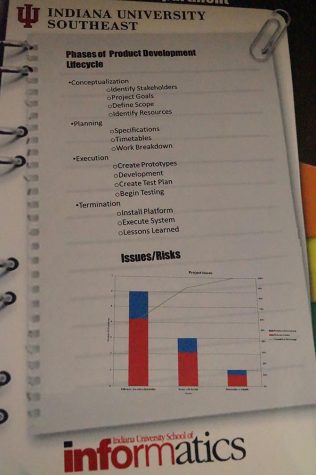Informatics Explained
February 16, 2017
Informatics may seem to be a relatively new field to many. According to Sridhar Ramachandran, associate professor and department chair of Informatics at IU Southeast, the opposite is actually true.
“The common misconception about Informatics is that it is a new discipline,” Ramachandran said. “It is not. It is one of the oldest disciplines. It came before computer sciences, before computer engineering, before [information technology]. It is the essence of what technology is supposed to do – technology was designed to solve open problems in other fields.”
Ramachandran said the history of informatics reaches back over 70 years.

“Computers were developed to decipher code and help with military operations [during World War II],” he said. “Counting machines were made to help with census data and counting so that it can be done at a faster rate, which solved an open problem in the sociology field. The use of technology to solve problems in other fields is what informatics is.”
Ramachandran, the founding faculty member of the department, said that informatics is the newest department at the IU Southeast School of Natural Sciences. The program was formed in 2006 with classes officially beginning in 2007. Ramachandran was the first one hired into the department, with another associate professor added in 2010.
Valeria Aramburu, academic advisor in the School of Natural Sciences, explained what the informatics degree entails.
“Informatics is learning to create new uses for technology and the way people interact with it,” Aramburu said. “You’ll learn things such as logical reasoning, basic programming, data visualization, human-computer interaction design and other skills that will help you put technology to better use.”
Aramburu said that the informatics degree requires students to choose a cognate, or specialization. There are more than 13 cognates that allow students to apply informatics to different areas such as criminal justice, biology, chemistry, digital media and psychology. Each cognate, designed to couple the use of technology with other industries, is worth 15 to 18 credit hours starting in a student’s sophomore year and being completed in a student’s junior year.

“Bio-informatics would be with a biology cognate,” Aramburu said. “There’s a health science track, so that’s about how to use technology in the health field.”
Ramachandran expanded on this explanation and how the psychology of the user is incorporated into the learning process.
“As each student starts learning about informatics, they then get to choose a field to solve an open problem in,” Ramachandran said. “If it’s criminal justice, for example, the student can look at the problems facing the daily task of a police officer and what type of technology can be in his car.”
Ramachandran said that companies have traditionally approached problems like this by assuming that connecting police cars together from one hotspot to another would be a good solution. However, the question comes in whether such a solution would enhance their work or hinder it. Individual police departments, according to Ramachandran, may have different answers.
Ramachandran also said that while informatics is not a new science, the idea of user psychology and incorporating the user in the process caused a rebirth period for informatics around the turn of this century.
“The biggest problem [in the advancement of technology] was the problem with society,” Ramachandran said. “Why do we have faster computers? Who is better software going to serve?”
Ramachandran said that informatics was reborn in 2001 because there was a lack of focus on the user. Computers have become more user-friendly because of the understanding of the psychology of users. According to Ramachandran, the philosophy behind informatics lies in asking the user how they want to use technology.
Aside from technology and its uses in other fields, the informatics program at IU Southeast contains other sociological components. The program contains an international dimension that has three different options to help students learn about other countries.
“One of the two most common options is that students can pick a list of two courses that have an international theme to them,” Aramburu said. “The second most common is taking three semesters of a foreign language. Since this is a Bachelor of Science degree, it doesn’t require a foreign language but students interested in learning a language can do that through the international dimension.”
Another facet of the informatics is the Design Development of Information Systems class, which is seen as a capstone class stretched out over two semesters. The final grade is given at the end of the second semester.
“Students have two options for that,” Aramburu said. “They can take the two classes or they can do an internship. With the capstone classes, you work with a group in the first semester and design a project, and the second semester you’re implementing the project.”
According to Aramburu, students have interned with Best Buy’s Geek Squad, Louisville Gas & Electric, UPS, Humana and Stericycle for those classes.
While the core of informatics is with technology, it is the psychology of how to best apply it that Ramachandran said is at the core of the program.
“Let’s understand human psychology,” he said. “Let’s understand the user. Let’s make technology an extension of the human being so that it makes life better. That is the essence of informatics.”

